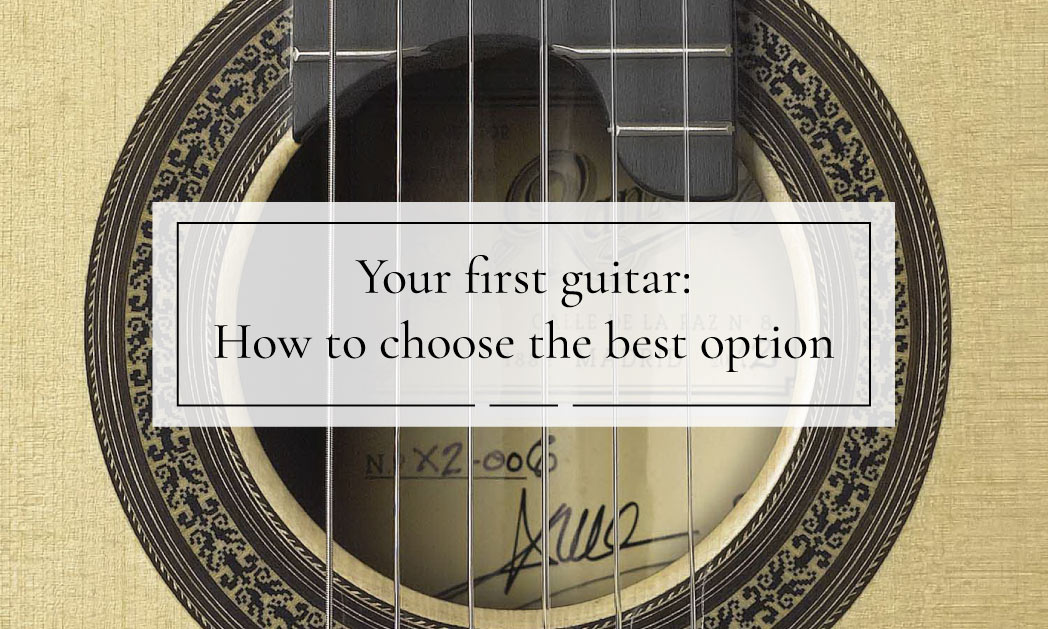After the first article I published on how to choose your handmade guitar, my teacher Ana Jenaro told me that it would be interesting to talk about how to choose your first guitar, especially if we are talking about children. Her student, also a teacher, Elena de Blas, told me the same thing, and she also suggested that I should write a series of chapters on this subject.
The importance of choosing your first guitar well
Selecting a guitar from among several, of whatever quality, requires a certain amount of reflection, research and time. The first thing we have to know is that it is an instrument that has a function and it is essential that it fulfils it correctly, that is to say, it is not a toy. And I say this, not because I think that whoever is reading me now does not know this premise, but because it is not the first time that, for ‘not spending too much’ and out of ignorance, we have come to the workshop with toy guitars bought in toy shops or bazaars.
Common mistakes when buying a guitar for the first time
It is also common for people to visit us with second-hand guitars which, in principle, should not be a problem. However, when they buy through these channels, they look at the price (first of all) and then at the aesthetic appearance, but they leave aside the fundamental question: is the guitar playable? Unfortunately, this is not always the case. I invite you to read the article written by my aunt Amalia on this subject, although I will make a small summary in this article: https://guitarrasramirez.com/en/how-to-value-a-second-hand-guitar/
Key tips for choosing a good guitar
The first advice I can give to anyone who chooses this path is to be accompanied by someone who knows how to play in order to see the instrument. The characteristics that I would fundamentally check are two: tuning and comfort. Playing the instrument should be a pleasure and not a torture. You should avoid strings (*1) that are too high and do not allow you to lower the bridge bone (*2), protruding frets (*3) that bother you when you pass your hand, annoying lisps in various areas of the fingerboard (*4). It would also be a good idea to check if the bridge (*5) is starting to peel or if there are open cracks (*6), i.e. not repaired. The varnish has an important function because it protects the wood and is a characteristic that we have to pay attention to, if we do not want to have problems over time. Vibrating sounds in the top (*7) which can indicate a detached internal element, etc.
Guitars for beginners
When you decide to buy a new guitar, it is logical and highly recommended to choose an inexpensive instrument when the child or adult wants to start and is not sure that he/she will like it and get hooked on it. That is why we advise against choosing guitars of a higher range, because until a certain technique is achieved, they will not be able to appreciate them. In this article I have no choice but to talk about what we have in our guitar shop in Calle de la Paz, although other shops or specialised workshops will be able to advise you correctly.
Recommended options for small children
Normally, small guitars are not designed for children under 6 years old, but not long ago both Ana and a student and friend of hers, also a teacher, José Emilio Navarro, told me that in these cases they used a Yamaha guitalele which, instead of tuning it to A (a 4th above) they tuned it to E, using guitar strings instead of guitalele strings.
In our shop we have for children the smallest guitar which is 1/4, followed by the 1/2, which is colloquially called cadete, and the largest which is 3/4. I can’t talk about ages because it all depends on the size of the child. We must always look after their comfort so that they don’t get frustrated and continue in the wonderful world of learning. If in doubt, it is better to buy one that is a little smaller than one that is too big.
The right time to switch to an adult guitar
Another of the doubts that arise when buying a guitar for a child is the longed-for moment when they can move on to an adult guitar, and therefore, one that can last them a lifetime if they look after it properly. As I mentioned in the previous paragraph, although this step is usually taken between the ages of 11 and 12, everything will depend on their size and it is not advisable to force the change. I will never tire of repeating that to enjoy music, comfort is a fundamental characteristic.
(*1) The strings are metal wires that are attached to the guitar. It is an element that with use and time wears out and needs to be replaced. It is not a repair, it would be similar to changing a battery. We recommend that you learn how to do it as soon as possible without the need to take it to a specialised place, as it is quicker and cheaper.
(*2) Piece where the strings are tied, which has a piece of bone embedded in a groove that regulates the comfort within certain limits. The head bone only affects the first 3 frets.
(*3) Metal elements that are nailed to the elongated piece of wood where the fingers of one of the hands are placed.
(*4) Elongated piece of wood where the frets are placed.
(*5) Piece of wood under the soundhole (round hole) to which the strings are attached.
(*6) Cracks that occur in the wood mainly because the relative humidity is not controlled or because of pressure at some point. It is recommended to repair them because over time they will tend to open up and could lead to the detachment of an important interior part.
(*7) Front part of the guitar where part of the fretboard, strings, bridge and soundhole are located.


